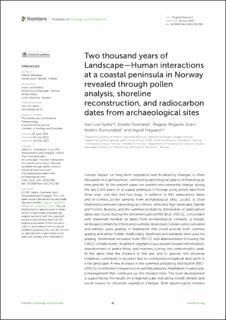| dc.contributor.author | Hjelle, Kari Loe | |
| dc.contributor.author | Overland, Anette | |
| dc.contributor.author | Gran, Magnar Mojaren | |
| dc.contributor.author | Romundset, Anders | |
| dc.contributor.author | Ystgaard, Ingrid | |
| dc.date.accessioned | 2023-02-22T13:19:34Z | |
| dc.date.available | 2023-02-22T13:19:34Z | |
| dc.date.created | 2022-09-15T14:10:18Z | |
| dc.date.issued | 2022 | |
| dc.identifier.citation | Frontiers in Ecology and Evolution. 2022, 10 1-18. | en_US |
| dc.identifier.issn | 2296-701X | |
| dc.identifier.uri | https://hdl.handle.net/11250/3053321 | |
| dc.description.abstract | Object-vector (OV) cells are cells in the medial entorhinal cortex (MEC) that track an animal’s distance and direction to objects in the environment. Their firing fields are defined by vectorial relationships to free-standing 3-dimensional (3D) objects of a variety of identities and shapes. However, the natural world contains a panorama of objects, ranging from discrete 3D items to flat two-dimensional (2D) surfaces, and it remains unclear what are the most fundamental features of objects that drive vectorial responses. Here we address this question by systematically changing features of experimental objects. Using an algorithm that robustly identifies OV firing fields, we show that the cells respond to a variety of 2D surfaces, with visual contrast as the most basic visual feature to elicit neural responses. The findings suggest that OV cells use plain visual features as vectorial anchoring points, allowing vector-guided navigation to proceed in environments with few free-standing landmarks. | en_US |
| dc.language.iso | eng | en_US |
| dc.publisher | Springer Nature | en_US |
| dc.rights | Navngivelse 4.0 Internasjonal | * |
| dc.rights.uri | http://creativecommons.org/licenses/by/4.0/deed.no | * |
| dc.title | Two thousand years of Landscape—Human interactions at a coastal peninsula in Norway revealed through pollen analysis, shoreline reconstruction, and radiocarbon dates from archaeological sites | en_US |
| dc.title.alternative | Two thousand years of Landscape—Human interactions at a coastal peninsula in Norway revealed through pollen analysis, shoreline reconstruction, and radiocarbon dates from archaeological sites | en_US |
| dc.type | Peer reviewed | en_US |
| dc.type | Journal article | en_US |
| dc.description.version | publishedVersion | en_US |
| dc.source.pagenumber | 1-18 | en_US |
| dc.source.volume | 10 | en_US |
| dc.source.journal | Frontiers in Ecology and Evolution | en_US |
| dc.identifier.doi | 10.3389/fevo.2022.911780 | |
| dc.identifier.cristin | 2052087 | |
| cristin.ispublished | true | |
| cristin.fulltext | original | |
| cristin.qualitycode | 1 | |

